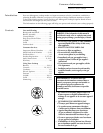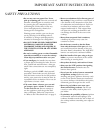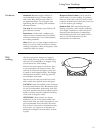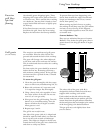
10
IMPORTANT SAFETY INSTRUCTIONS
SURFACE COOKING
• Always turn the surface burners to OFF
before removing cookware.
• Carefully watch foods being fried at a high
flame setting.
• Foods for frying should be as dry as possible.
Frost on frozen foods or moisture on fresh
foods can cause hot fat to bubble up and over
the sides of the pan.
• Use the least possible amount of fat for
effective shallow or deep fat frying. Filling
the pan too full of fat can cause spillovers
when food is added.
• Use a deep fat thermometer whenever
possible to prevent overheating fat beyond
the smoking point.
• Never try to move a pan of hot fat, especially
a deep fat fryer. Wait until the fat is cool.
• When using glass cookware, make sure it is
designed for cooktop cooking.
• If a combination of oils or fats will be used
in frying, stir together before heating or as
fats melt slowly.
• Do not leave any items on the cooktop. The
hot air from the vent may ignite flammable
items and will increase pressure in closed
containers, which may cause them to burst.
• Use proper pan size—avoid pans that are
unstable or easily tipped. Select cookware
having flat bottoms large enough to properly
contain food and avoid boilovers and
spillovers and large enough to cover burner
grate. This will both save cleaning time and
prevent hazardous accumulations of food,
since heavy spattering or spillovers left on the
cooktop can ignite. Use pans with handles
that can be easily grasped and remain cool.
• Keep all plastics away from the top burners.
• Do not leave plastic items on the cooktop—
they may melt if left too close to the vent.
• To avoid the possibility of a burn, always be
certain that the controls for all burners are at
the OFF position and all grates are cool
before attempting to remove them.
• When flaming foods under the hood, turn
the fan on.
• Grease is flammable. Let hot grease cool
before attempting to handle it. Avoid letting
grease deposits collect in the grill or the
griddle drip trays. Clean these areas after
each use.
• For proper lighting and performance of the
cooktop burners, keep the burner ports
clean. It may be necessary to clean these
when there is a boilover or when the burner
does not light, even though the electronic
ignitors click.
• After cleaning, it is important to make sure
the cap and burner port are properly aligned
with the burner base. Incorrect alignment
will produce poor burner performance.
Never operate the burner without all burner
parts in place.
• Clean the cooktop with caution. Avoid steam
burns; do not use a wet sponge or cloth
to clean the cooktop while it is hot. Some
cleaners produce noxious fumes if applied
to a hot surface. Follow manufacturer’s
directions.
• Do not use the grill for cooking excessively fatty
meats or products which promote flare-up.
• If cooktop is located near a window, do not
hang long curtains that could blow over the
surface burners and create a fire hazard.
• Be sure all the cooktop controls are turned
off and the appliance is cool before using
any type of aerosol cleaner or cooking spray
on or around the appliance. The chemical
that produces the spraying action could, in
the presence of heat, ignite or cause metal
parts to corrode.


















